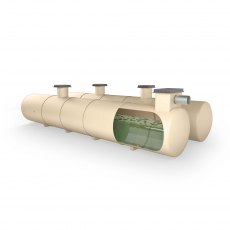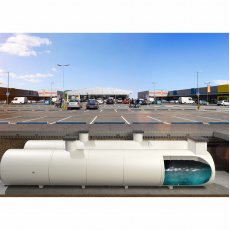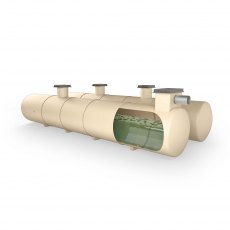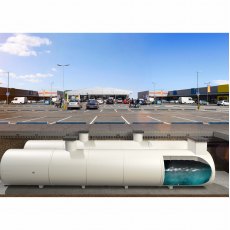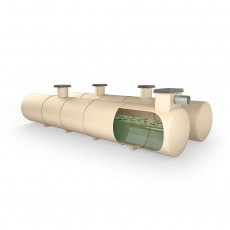AquaHold Attenuation Tanks Range FAQs
What does SuDs mean?
SuDs stands for Sustainable Drainage Systems. They are systems designed to be environmentally beneficial, to ensure minimal or no long-term detrimental damage to the surrounding environment. It is a term used to describe control strategies or products that allow the efficient and sustainable drainage of surface water, to help minimise pollution and manage the impact on water quality in local water bodies.
SuDs help to manage surface rainfall run-off by controlling the rate and volume of the runoff. This helps to relieve pressure on sewerage systems, imitating natural drainage as closely as possible. SuDs can help local authorities, planners, architects, and developers deliver greener infrastructure.
What are the advantages of a SuDS?
Sustainable drainage systems (SuDS) present an opportunity to add value to a project, while meeting local planning requirements around increasing sustainability and managing flood risk. They can help save you time and money but that’s not all.
SuDS reduce the impact of urbanisation on flooding, by managing runoff and flow rates from hard surfaces. They provide opportunities for using runoff where it falls, such as rainwater harvesting, that in turn helps to reduce both the flow into sewers and our dependency on mains water. Some SUDs can help to reduce pollution, protecting the quality of downstream water bodies such as streams, rivers, lakes, bathing, or shellfish waters. They preserve the natural flow regimes in watercourses and, by being sympathetic to the environment and the needs of the local community, create better places to live, work and visit. Urban watercourses can provide an attractive habitat for wildlife, as well as providing opportunities for evapotranspiration from vegetation and surface water.
What types of SuDs are available?
Bypass and full retention separators
Sometimes known as petrol interceptors, bypass and full retention separators are designed to manage runoffs and spills, whether that’s from large amounts of rainfall or the accidental spillage of oil or fuel. These separators will protect your local environment from pollutants and help reduce the risk of large fines from the Environment Agency. Full retention separators are used when there’s a medium to high risk of contamination caused by spillage or flooding, for example in large car parks, industrial workshops, and recycling centres. Bypass separators are used when the area has a low risk of contamination, such as roadways or commercial areas that would only get light contamination. It can cope with water flow generated by rainfall up to 6.5mm per hour.
Domestic rainwater harvesting
Rainwater harvesting is an eco-friendly way of reducing water usage in your home. There are two types of systems available – direct and in-direct. In a direct system, harvested water is pumped directly to the appliances, whereas in an in-direct system, the harvested rainwater gets stored in a holding tank and gravity feeds the appliances. The harvested water can be used for a variety of appliances, including toilets, showers, baths, sinks and washing machines.
Surface water treatment separators
Surface water treatment separators (SWT) reduce pollution in line with SuDs Mitigation Indices by removing metals, hydrocarbons, and suspended solids from surface water. Our SWTs are lightweight and easy to install and can be maintained and serviced from ground level.
Vertical and horizontal flow control solutions
Designed to control the flow of water into local watercourses, flow control solutions reduce the risk of flooding on natural habitats and prevent bank erosion.
Vertical and horizontal pump stations
Used in housing estates, hospitals, and commercial sites, sewage pumping stations transport sewage or wastewater when gravity cannot naturally carry it, such as where a sewer line may travel up an incline or over a ridge. They work by collecting wastewater and storing it in a chamber. When the chamber is full, a high-pressure integral pump lifts the sewage through a discharge system before pumping it into a sewage treatment works.
What are the three types of SuDS?
SuDS stands for Sustainable Drainage Systems, which are designed to manage surface water runoff in a more sustainable and environmentally friendly manner. There are three main types of SuDS:
Source control SuDS focus on managing surface water as close to its origin as possible. It involves techniques such as green roofs, permeable paving, rainwater harvesting, and infiltration trenches. The aim is to prevent water from entering the drainage system in the first place, reducing the risk of flooding and pollution.
Site control SuDS manage surface water at or near the development site. Techniques include swales, detention basins, ponds, and wetlands. These features capture and slow down the flow of water, allowing pollutants to settle out and providing habitat for wildlife.
Regional control SuDS manage surface water at a broader scale, typically at the catchment or watershed level. These systems include sustainable urban drainage networks (SUDS), which connect multiple sites and utilise natural features such as rivers, streams, and floodplains to attenuate and manage runoff. Regional control SuDS aim to reduce flood risk and protect water quality across entire landscapes.
Embracing SuDS not only mitigates flood risk and safeguards water quality but also fosters more resilient and liveable communities amidst the challenges posed by escalating urbanisation and the impacts of climate change.
How do SuDS work?
SuDS function by intercepting rainwater at the source, using techniques such as green roofs, permeable pavements, and rain gardens right where the rain falls. By doing so, SuDS reduce the amount of water entering traditional drainage systems, thus alleviating the risk of flooding in your area. Essentially, SuDS work by capturing rainwater before it has a chance to become runoff. SuDS then employ a variety of site-based measures to manage rainwater effectively. For instance, features like swales, detention basins, and ponds are strategically placed across landscapes to slow down the flow of water and allow for natural infiltration. These help to prevent the overwhelming of drainage systems, minimising the risk of flooding. SuDS incorporate regional-scale solutions to address broader drainage challenges within entire catchment areas. This involves the creation of sustainable urban drainage networks (SUDS) that connect various sites and utilise natural features like rivers, streams, and wetlands to manage stormwater. By taking a holistic approach, SuDS mitigate flood risk not just at a local level but across entire landscapes, providing comprehensive protection for communities like yours.
SuDS promote the infiltration and storage of rainwater within the landscape, rather than allowing it to rapidly runoff into drainage systems. This helps to replenish groundwater resources and sustain baseflow in rivers and streams, contributing to overall water resource management. By allowing rainwater to filter through soil and vegetation, SuDS remove pollutants and improve water quality, benefiting not only the environment but also your health and wellbeing.
What are the main benefits of SuDS?
SuDS offer effective flood risk management in your community. By intercepting and managing rainwater close to its source, SuDS reduce the volume and speed of runoff entering traditional drainage systems during heavy rainfall. This proactive approach helps to alleviate the pressure on infrastructure, minimising the risk of flooding and safeguarding your property from water damage. And, by promoting natural infiltration and filtration processes, SuDS remove pollutants, sediments, and debris from stormwater runoff before it reaches water bodies such as rivers, lakes, and streams. Cleaner water not only benefits aquatic ecosystems and wildlife but also enhances recreational opportunities and the overall aesthetic appeal of your surroundings. SuDS also provide a sustainable solution to manage stormwater in a changing climate. By incorporating green infrastructure elements such as green roofs, permeable pavements, and vegetated swales, SuDS help to mitigate the effects of urban heat islands, reduce surface runoff, and adapt to shifting weather patterns.
SuDS offer multiple benefits beyond flood risk management and water quality improvement. For instance, green spaces and vegetated features incorporated into SuDS provide habitat for wildlife, support biodiversity, and enhance the overall ecological health of your environment. They contribute to the creation of more attractive and liveable communities, with green spaces, parks, and recreational areas that enhance your quality of life and well-being.


